Science & Environment
America’s coal communities could help the U.S. triple nuclear power
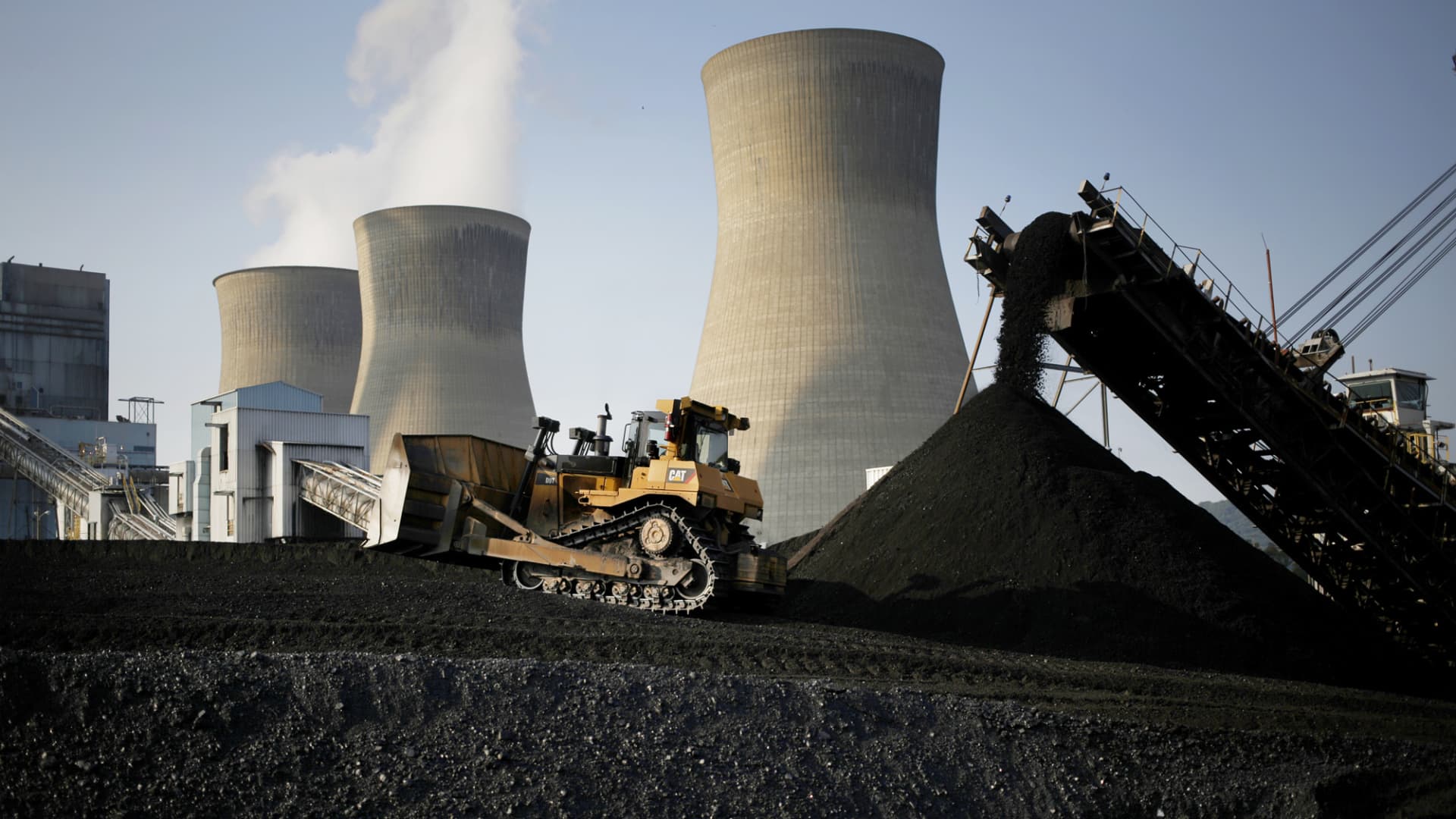
A bulldozer moves coal that will be burned to generate electricity at the American Electric Power coal-fired power plant in Winfield, West Virginia.
Luke Sharrett | Bloomberg | Getty Images
The planned restart of Three Mile Island is a step forward for nuclear power, but the U.S. needs to deploy new plants to keep up with rising electricity demand, one of the nation’s top nuclear officials said this week.
The U.S. needs to at least triple its nuclear fleet to keep pace with demand, slash carbon-dioxide emissions and ensure the nation’s energy security, said Mike Goff, acting assistant secretary for the Office of Nuclear Energy at the Department of Energy.
The U.S. currently maintains the largest nuclear fleet in the world with 94 operational reactors totaling about 100 gigawatts of power. The fleet supplied more than 18% of the nation’s electricity consumption in 2023.
The U.S. needs to add 200 gigawatts of nuclear, Goff told CNBC in an interview. This is roughly equivalent to building 200 new plants, based on the current average reactor size in the U.S. fleet of about a gigawatt.
“It’s a huge undertaking,” Goff said. The U.S. led a global coalition in December that formally pledged to meet this goal by 2050. Financial institutions including Goldman Sachs and Bank of America endorsed the target at a climate conference in New York City this week.
Constellation Energy‘s plan to restart Three Mile Island by 2028 is a step in the right direction, Goff said. The plant operated safely and efficiently, only shutting down in 2019 for economic reasons, he said.
The reactor that Constellation plans to re-open, Unit 1, is not the one the partially melted down in 1979.
Microsoft will purchase electricity from the plant to help power its data centers. Goff said the advent of large data centers that consume up to a gigawatt of electricity only reinforces the need for new reactors.
“A lot of the data centers are coming in and saying they do need firm, 24/7, baseload clean electricity,” Goff said. “Nuclear is obviously a perfect match for that,” he said.
But restarting reactors in the U.S. will only provide a small fraction of the nuclear power that is needed, he said. There are only a handful of shuttered plants that are potential candidates for restarts, according to Goff.
“It’s not a huge number,” Goff said of potential restarts. “We need to really be moving forward also on deploying plants,” he said.
From coal to nuclear
Coal communities across the U.S. could provide a runway to build out a large number of new nuclear plants. Utilities in many parts of the U.S. are phasing out coal as part of the clean energy transition, creating a supply gap in some regions because new generation is not being built fast enough.
Recently shuttered coal plants, those expected to retire, and currently operating plants with no estimated shutdown date yet could provide space for up to 174 gigawatts of new nuclear across 36 states, according to a Department of Energy study published earlier this month.
Coal plants already have transmission lines in place, allowing reactors at those sites to avoid the long process of siting new grid connections, Goff said. The plants also have people experienced in the energy industry who could transition to working at a nuclear facility, he said.
“We can actually get a significant cost reduction by building at a coal plant,” Goff said. “We can maybe get a 30% cost reduction compared to just going on a greenfield site.”
Cost overruns and long timelines are major hurdles for building new nuclear plants. The expansion of the Vogtle plant in Georgia with two new reactors, for example, cost more than $30 billion and took around seven years longer than expected.
Expanding operational nuclear plants and building at retired sites in the U.S. could create a pathway for up to 95 gigawatts worth of new reactors, according to the DOE study. Between coal and nuclear sites, the U.S. potentially has space for up to 269 gigawatts of additional nuclear power.
The potential capacity would depend on whether advanced, smaller reactors are built at the sites, or larger reactors with a gigawatt or more of power.
More electricity could potentially be generated if the smaller reactors were rolled out on a large scale because there is space for more them, according to the DOE study. Some of these smaller advanced designs, however, are still years away from commercialization.
But rising electricity demand from data centers, manufacturing and the electrification of the economy could provide a catalyst to build the larger plants as well, according to Goff. The Three Mile Island restart, for example, would bring back just under a gigawatt of power to meet Microsoft’s needs.
“That increased power demand, that will lead toward an additional push toward those gigawatt size reactors as well,” he said.
Restarts likely to secure greenlight
While reactor restarts aren’t a silver bullet, shoring up and maintaining the existing fleet is crucial, Goff said. The U.S. went through a decade-long period in which reactors were shutting down because they could not compete with cheap, abundant natural gas.
The economics are changing, however, with tax support from the Inflation Reduction Act and nuclear increasingly valued for its carbon-free attributes, Goff said.
“One of the issues with the economics, especially in the non-regulated utilities, was there was no value necessarily for clean, baseload electricity,” he said. “There is a lot more recognition of the need for that clean, firm, reliable baseload for nuclear”
Constellation’s decision to restart Three Mile Island follows in the footsteps of the Palisades nuclear plant in Michigan. The private owner, Holtec International, plants to restart Palisades in 2025. The two restarts are subject to review and approval by the Nuclear Regulatory Commission.
“They are an independent agency, but I expect if the safety cases are presented, they’re going to approve it,” Goff said of those potential restarts.
“Constellation obviously operated the Three Mile Island plant for years, and has a very large fleet of reactors that they’ve operated safely and efficiently,” he said. “They will continue to have a great expertise in moving those plants to continue their safe operation.”
But finding additional plants to restart could prove difficult, said Doug True, chief nuclear officer at the Nuclear Energy Institute.
“It gets harder and harder,” True previously told CNBC. “A lot of these plants have already started the deconstruction process that goes with decommissioning and the facility wasn’t as thoroughly laid up in a way that was intended to restart in any way.”
Science & Environment
Oil alliance OPEC+ zeroes in on group compliance

Dilara Irem Sancar | Anadolu | Getty Images
The OPEC+ alliance is once more cracking down on group compliance with oil output cuts, as it presses ahead with a three-pronged plan of formal and voluntary production trims.
Two OPEC+ delegates, who could only comment anonymously because of the sensitivity of the talks, told CNBC that the coalition has sharpened its focus on the conformity of its members with their output pledges, amid repeat overproduction from heavyweight members such as Iraq and Kazakhstan.
Russia, whose barrels are sanctioned in the West and transported with lower visibility across a shadow fleet, has also at times exceeded its assigned quota under the alliance’s formal policy, one of the sources said.
Eight OPEC+ members, including kingpin Saudi Arabia, were due to begin returning 2.2 million barrels per day (bpd) of voluntary cuts to the market starting in October. Earlier this month, they postponed this phase-out to start in December instead. OPEC+ nations are operating two other production declines: under official policy, they will produce a combined 39.725 million bpd next year. The same aforementioned eight members are separately curbing their output by another 1.7 million bpd throughout 2025, also on a voluntary basis.
Undercompliance has been a repeat bane of the OPEC+ alliance, casting a shadow over the credibility of its intentions to cut output – at a time of market uncertainty exacerbated by war in the hydrocarbon-rich Middle East, recent stock selloffs and a fragile post-Covid recovery in the world’s top crude importer, China.
Oil prices have remained subdued for the better part of the year and dropped sharply on Thursday, following a Financial Times report stating that OPEC+ de facto leader Saudi Arabia was prepared to suffer through a low-price environment and abandon an unofficial $100-per-barrel price target to bolster its output after December.

Brent crude futures with November expiry were trading at $71.44 per barrel at 2:30 p.m. London time, down 0.17% from the Thursday settlement. The front-month November Nymex WTI contract was at $67.75 per barrel, flat from the previous session’s close.
“I would read it more as the Saudis sending some warning to the cheaters within OPEC. Because I think Saudi Arabia has seen most of the burden of the production cuts,” Carole Nakhle, founder and CEO of Crystol Energy, told CNBC’s Dan Murphy Friday, referring to the FT report.
Speaking of the group’s possible approach to price targeting, Nakhle added, “Of course, the higher the better for them, but nothing has been set in stone.”
OPEC+ ministers, including Saudi Prince Abdulaziz bin Salman, have previously insisted that their policies target diminishing global stocks rather than an explicit price, although decisions to tighten supplies typically offer support to crude futures in the long term. But several member countries, including the Saudi kingdom, underpin their annual budgets on the assumption of a fiscal break-even price — which the International Monetary Fund estimates must hit $96.20 for Riyadh to meet its obligations this year.
Riyadh is locked in an extensive and costly program spanning 14 giga-projects, including the futuristic desert development Neom, to materialize Saudi Crown Prince Mohammed bin Salman’s ambition of economic diversification away from reliance on hydrocarbon revenues.

Despite the economic pressures of enforcing the Vision 2030 program, Saudi Arabia has yet to change its OPEC+ approach and does not target an explicit oil price, one of the OPEC+ sources told CNBC, noting that Riyadh can reshape its budget or shore it up through alternative, non-oil revenues.
Earlier this month, Saudi Minister for Investment Khalid al-Falih pushed back against lingering skepticism over the country’s economic diversification plan, touting “green shoring” investment opportunities to lure foreign financing.
The prospect of Saudi Arabia weaponizing its vast production capacity to settle OPEC+ disputes is not without precedent. Back in 2020, Riyadh and Moscow engaged in a weeks-long price war in the wake of the abrupt but fleeting dissolution of the OPEC+ alliance, flooding the market at a time of already excess supply and dried-up demand amid the spreading Covid-19 pandemic — and briefly ushering WTI futures into negative territory.
OPEC+ receives monthly production figures — which assist it to calculate member compliance — from seven independent secondary sources. The coalition’s Joint Ministerial Monitoring Committee, a technical group that oversees OPEC+ conformity, is due to next meet on Oct. 2.
Science & Environment
WTI heads for weekly loss as supplies rise

U.S. crude oil on Friday was on pace for its first weekly loss in three weeks, as the prospect of growing oil supplies from Saudi Arabia overshadowed China’s efforts to stimulate its economy.
The U.S. benchmark West Texas Intermediate is down nearly 6% this week, while global benchmark Brent has pulled back nearly 4%. Prices have fallen even as conflict in the Middle East escalates, with Israel and Hezbollah trading blows in Lebanon.
“It is amazing to see that … war doesn’t affect the price, and that’s because there’s been no disruption,” Dan Yergin, vice chairman of S&P Global, told CNBC’s “Squawk Box” Friday.
“There’s still over 5 million barrels a day of shut in capacity in the Middle East,” Yergin said.
Here are Friday’s energy prices:
- West Texas Intermediate November contract: $67.51 per barrel, down 16 cents, or 0.24%. Year to date, U.S. crude oil is down more than 5%.
- Brent November contract: $71.37 per barrel, off 23 cents, or 0.32%. Year to date, the global benchmark is down about 7%.
- RBOB Gasoline October contract: $1.9596 per gallon, little changed. Year to date, gasoline is down about 7%.
- Natural Gas November contract: $2.774 per thousand cubic feet, up 0.76%. Year to date, gas is up about 10%.
Oil sold off Thursday on a report that Saudi Arabia is committed to increasing production later this year, even if it results in lower prices for a pro-longed period.
OPEC+ recently postponed planned output hikes from October to December, but analysts have speculated that the group might delay the hikes again because oil prices are so low.
The oil selloff erased gains from earlier in the week after China unveiled a new round of economic stimulus measures. Soft demand in China has been weighing on the oil market for months.
“The thing that’s dominated the market is the weakness in China. Half the growth in world oil demand over a number of years has simply been in China, and it hasn’t been happening,” Yergin said.
“The big question is, stimulus, will you see a recovery in China,” he said. “That’s what the market is struggling with.”
Science & Environment
Queen guitarist Brian May quits as VP over food label
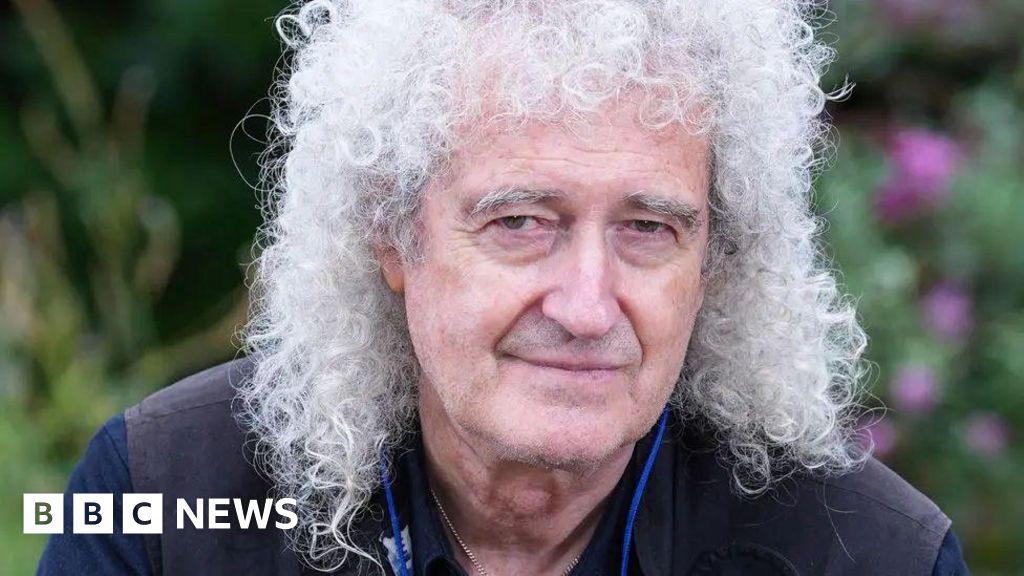
 PA Media
PA MediaQueen guitarist Sir Brian May has quit as the RSPCA’s vice-president over what he called “damning evidence” of animal welfare failings related to its food certification label.
BBC News reported on Thursday that the association had to run spot checks on more than 200 ‘RSPCA Assured’ farms to ensure they met its own standards.
Animal welfare activists say their own undercover investigations found the scheme covering around 4,000 farms was failing to ensure even basic legal standards. They also want RSPCA president Chris Packham to stand down.
The RSPCA said it had “different views from Brian on how best to approach this complex challenge”.
The BBC has reached out to conservationist and TV presenter Mr Packham for comment.
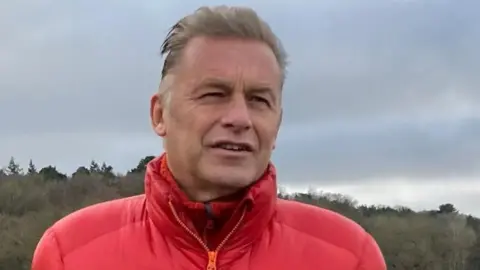
Sir Brian, who has long campaigned on animal welfare issues and against the culling of badgers to protect farms from bovine TB, published his letter of resignation on Instagram.
In it, he said: “It is with profound sadness and not without massive soul-searching that today I have to offer my resignation as a vice-president of the RSPCA.”
He said he had been kept informed “of complaints that have been levelled in recent months at the RSPCA over appallingly bad standards of animal welfare in member farms of the RSPCA Assured scheme.
“I have understood that the RSPCA needed time to evaluate the evidence and make decisions on action to be taken.
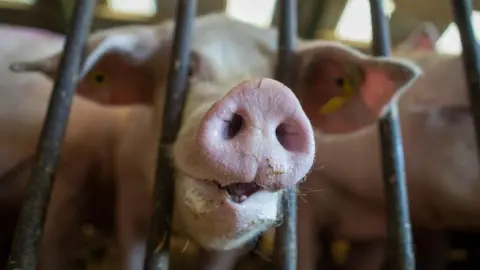 Getty Images
Getty Images“But as more and more damning evidence comes to light, I find the RSPCA’s response completely inadequate.”
He added that as the supervision of the scheme had “failed”, it needed to be dismantled.
Allegations against around 40 farms in the RSPCA Assured scheme that were investigated by animal welfare activists included overcrowding, poor hygiene and in some cases, physical abuse of livestock by farm workers.
Chris Packham has also called for the scheme to be suspended but has not yet commented on his future in the role.
Claire Palmer, director of Animal Justice Project, one of 60 groups that sent an open letter on Thursday calling for the scheme to be abandoned, told the BBC that they were “relieved that Brian May has made the responsible decision to step down as Vice President”.
‘Robust action’
“Years of undercover investigations have revealed the systemic failures of the RSPCA Assured scheme. The RSPCA must be bold and take decisive action now,” she added.
The RSPCA Assured scheme – originally known as Freedom Food – was launched 30 years ago and covers meat, fish, eggs and dairy. Certified farms have to follow strict welfare standards that are set out by RSPCA welfare scientists and are higher than is legally required in the UK.
An RSPCA spokeswoman said it respects Sir Brian’s “views and understands his decision” before adding: “His ongoing and devoted work campaigning on issues such as the badger cull and hunting have been invaluable for all animals and we look forward to speaking up on these issues with him in the future.”
The spokeswoman also called farming “hard, and farmed animal welfare is even harder”.
But, she added, the RSPCA wanted to “give our supporters, partners and the public confidence that RSPCA Assured is consistently delivering better welfare than standard farming practices.
“So, we launched an independent review of RSPCA Assured, which has been carried out over several months, including unannounced visits to more than 200 members of the scheme.
“Once we have analysed our findings, we will take any robust action necessary.”
Science & Environment
Sycamore Gap sapling gifted in memory of boy with cancer

 Dan Monk Kielder Observatory
Dan Monk Kielder ObservatoryRuth lost her only child Fergus to cancer when he was just 12.
“Your worst fear after your child dies is that he’ll be forgotten,” she explains.
They had long been searching for a tree with special meaning to plant in Fergus’ memory and to draw attention to all the children affected by childhood cancer.
The Sycamore Gap tree was cut down a year ago, sparking national outrage. Now, Fergus’ community in Backwell, near Bristol, will be one of the first to be gifted a sapling grown from it.
Stories of these first saplings to be promised are being shared to inspire others to apply for a ‘Tree of Hope’ from the National Trust. They have now grown to about 5ft tall, the BBC discovered on a visit to the top-secret greenhouse where they are kept.
 Yard family photo
Yard family photoOn a bank, overlooking an open green space, Fergus’ parents share the spot where his tree will go – a prominent place in the landscape.
Their son came to this recreational ground nearly every day – a boy, on the cusp of becoming a teenager, who had a love of the outdoors.
It was his walk to school. He played cricket and other games here with his dad Ian, who described it as place filled with “fun”.
Father and son were planning to walk Hadrian’s Wall, along which the Sycamore Gap tree was nestled.
They postponed because of the pandemic with the hope of visiting once life went back to ‘normal’.
But Fergus was diagnosed with Osteosarcoma (bone cancer) in January 2021 and was just 12 years old when he died in May 2022.
 Andy Alcroft/BBC
Andy Alcroft/BBC Two years on, his mum Ruth contacted the National Trust after hearing about the seedlings and grafts successfully grown from seeds and young twigs rescued from the felled tree.
“There’s something about the story of the new life being created from the Sycamore Gap. It made me think of all the children affected by childhood cancer. And how they deserve so much better. They deserve a second chance of life.”
A Sycamore Gap sapling seemed a fitting tribute as it was the trip planned, but never taken.
Since Fergus died, nature has been a constant source of strength to the family, Ruth tells me: “Its power to regenerate. And to console.”
She stresses that cancer in children is “horrendous, brutal and life-changing” and that bone cancer in children is something “no one really talks about”.
“We need to do more. We need to know more.” So her hope for the tree is to draw attention to the challenges these children face.
 Ross James/BBC
Ross James/BBCThe original tree was 49ft (15m) when it was chopped down, and so 49 of its saplings will be released to communities across the UK who successfully apply.
The Sycamore Gap stood in a dip in Hadrian’s Wall in Northumberland, attracting visitors, proposals and was even featured in the Hollywood blockbuster Robin Hood: Prince of Thieves.
But on the morning of 28 September 2023, news spread internationally that the tree had been chopped down overnight.
Two men accused of damaging the tree and wall both deny the offence.
There was excitement over the summer when shoots started to emerge from the stump itself.
Currently its ‘baby trees’ are being nurtured and protected in a secret greenhouse, a site of biosecurity because of the rare specimens grown there – including a copy of Newton’s Apple Tree.
The first of the seedlings to pop up has been gifted to King Charles.
It was the wrong time of year to grow the material that was salvaged from the iconic tree and things have been “touch and go”, Darryl Beck, who has been tending to the seedlings explains.
 Reuters
ReutersBut now the small team here are caring for about 100 saplings, some taller than 1.5m, and more seedlings are coming on.
There are also “nine or so grafts and budded plants” Chris Trimmer who runs the site explains. They are genetic copies of the original tree.
The trees wont be ready for planting until next year.
“We’re only a very small part of the story, but these trees will be around for the next 200 to 500 years. So, they’ll be around a long time and give a lot of hope to people,” says Chris.
The National Trust wants these saplings to be symbols of hope and healing, with each tree going to a very special place.
Another is promised to Tina’s Haven at Easington on the County Durham Coast.
Some 34 hectares (84 acres) of coastal fields are set to become a landscape of rolling meadows, hedgerows, ponds and woodlands overlooking the North Sea.
“My daughter Tina was absolutely a unique human being,” Sue Robson explains. “Through her life, although she had issues with childhood trauma and addiction and mental health, she was bold, she was strong, she was beautiful.”
 Sue Robson
Sue RobsonTina died in 2020, age 35, following these struggles. After her death, Sue wanted to create a wild sanctuary – a place of recovery for others dealing with the problems Tina faced.
The National Trust says it’s spent the last 40 years cleaning up the beaches that neighbour the former coalfield sites near where Tina’s Haven will be established.
The hope is not only to restore nature here, but to help women recover from addiction and trauma through rewilding projects.
Sue describes the pilgrimages she made to the Sycamore Gap, just 58 miles away, and how seeing it chopped down felt like an act of “violence against mother nature itself”.
“When Tina died, my hope died with her,” Sue says. “And equally, when that beautiful tree was cut down. It was a violent, devastating act.”
But she sees a “parallel” when it comes to themes of “hope, of nature, of recovery and connection.”
“So, having the tree, such a significant symbol of hope here, is absolutely massive.”
For Sue, the story of nature bouncing back, symbolises that even after being subject to the worst adversity, there can be recovery, healing and new beginnings.
“And hope can grow in abundance.”
Additional Reporting by Kristian Johnson
Science & Environment
WTI below $68 as Saudi committed to higher output
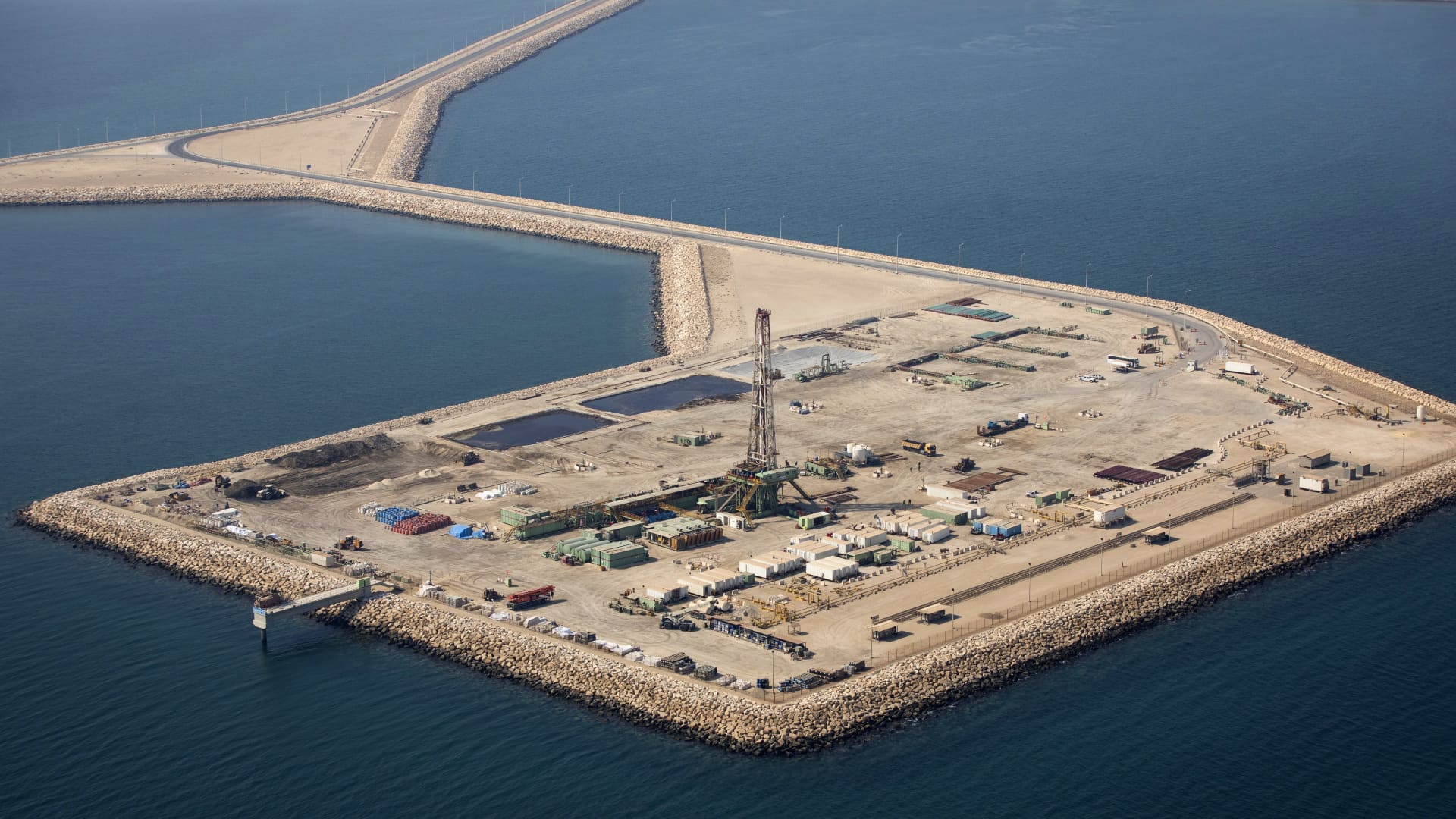

U.S. crude oil prices fell nearly 3% on Thursday on a report that Saudi Arabia is committed to pressing ahead with production increases later this year.
Saudi is prepared to ditch its unofficial oil price target of $100 per barrel, people familiar with the kingdom’s thinking told The Financial Times. Saudi officials are ready to increase oil production in December even if the move results in a prolonged period of low oil prices, the people said.
Here are Thursday’s energy prices:
- West Texas Intermediate November contract: $68.15 per barrel, down $1.54, or 2.21%. Year to date, U.S. crude oil is down about 5%.
- Brent November contract: $71.86 per barrel, down $1.60, or 2.2%. Year to date, the global benchmark is down nearly 7%.
- RBOB Gasoline October contract: $1.964 per gallon, down 1.7%. Year to date, gasoline is down about nearly 6%.
- Natural Gas October contract: $2.628 per thousand cubic feet, up 0.3%. Year to date, gas is up more than 4%.
Prices are also under pressure on the expectation that oil production will rise in Libya. Factions in the North African country reached a deal Wednesday to appoint a new central bank governor. A political dispute over who should lead the bank has led to production disruptions.
The prospect of rising production is set against a backdrop of soft demand in China, the world’s largest crude importer and second-largest consumer. Oil prices rallied earlier in the week after Beijing announced a new stimulus package.
Science & Environment
AI-adjacent companies may be the next big play

Inside one of Equinix’s internal operations at Equinix Data Center in Ashburn, Virginia, on May 9, 2024.
Amanda Andrade-Rhoades | The Washington Post | Getty Images
This report is from today’s CNBC Daily Open, our international markets newsletter. CNBC Daily Open brings investors up to speed on everything they need to know, no matter where they are. Like what you see? You can subscribe here.
What you need to know today
U.S. markets slipped as Asian stocks rise
U.S. stocks mostly fell Wednesday. The S&P 500 lost 0.19% and the Dow Jones Industrial Average slipped 0.7%, while the Nasdaq Composite closed near the flatline. Asian markets rose Thursday, with Hong Kong, Japanese and Korean markets adding more than 2%. They were buoyed by a semiconductor rally, led by SK Hynix shares which surged around 8%.
OpenAI might be open to profit
OpenAI’s board is considering plans to restructure the firm as a for-profit business, according to a source who asked to remain anonymous. OpenAI will retain its non-profit segment as a separate entity, the source said. The news follows a slew of high-profile departures from the company, like CTO Mira Murati and research chief Bob McGrew.
Support for semiconductor plans
Indian Prime Minister Narendra Modi plans to turn the country into a semiconductor powerhouse. Modi wants to grow the electronics sector from $155 billion currently to $500 billion by 2030. Experts CNBC talked to are divided over whether that target’s feasible. They are unanimous, however, on the fact that India can’t do it alone.
Turning VR into reality
Meta took another step in making virtual reality part of our everyday life. The company’s Reality Labs division announced the Quest 3S, its latest VR headset, which starts at $299 and goes on sale Oct. 15. Meta also showed off a prototype of augmented reality glasses called Orion. It hopes to sell the next version to consumers.
[PRO] Look at India’s ‘micros’
India’s economy and stock market have been booming over the past year. But it’s a mistake to invest based solely on that fact, said Blackstone Private Equity’s head of Asia. Instead, investors should focus on “certain micros” to make money.
The bottom line
The initial frenzy in generative artificial intelligence was triggered when OpenAI released ChatGPT in 2022. Institutions poured billions into OpenAI.
While OpenAI, the company behind ChatGPT, is not listed publicly, several companies have gained immensely from the generative AI boom that it sparked.
Nvidia was the first beneficiary of gen AI. Its stock rocketed in 2023, a year after ChatGPT was released, when it became clear the semiconductor company’s chips were the brains behind chatbots.
Then Big Tech companies jumped on the bandwagon. Microsoft, Meta and Google-parent Alphabet released their own versions of chatbots and gen-AI-infused tools. Those features helped bump up share prices, though of course it’s difficult to attribute a single cause to stock movement.
It seems the tailwinds of AI are starting to propel a third wave of AI-adjacent companies forward.
If chips are the brains of AI, then data centers are its body. Hewlett Packard Enterprise rose more than 5% after Barclays upgraded the company on strong AI data center demand. And recall Oracle’s surge this year, driven mainly by the company’s AI cloud services powered by its data centers.
Next in line to be juiced by AI appear to be energy companies.
Oracle’s founder Larry Ellison said a new data center that the company is designing “will rely on three modular nuclear reactors.”
Vistra Corp, a power company based in Texas, jumped almost 6% on expectations the company will power an AI data center with one of its nuclear plants. Likewise, Constellation Energy popped about 22% Friday after it announced plans to restart a nuclear plant and sell the power to Microsoft.
All that is to say: The AI wave will continue rippling throughout the ocean for some time. Big Tech or semiconductors are juicy catches, but a wider net might reel in other prizes.
– CNBC’s Kif Leswing, Jonathan Vanian, Jordan Novet, Brian Evans and Jesse Pound contributed to this story.
-

 Womens Workouts4 days ago
Womens Workouts4 days ago3 Day Full Body Women’s Dumbbell Only Workout
-

 News5 days ago
News5 days agoOur millionaire neighbour blocks us from using public footpath & screams at us in street.. it’s like living in a WARZONE – WordupNews
-

 News1 week ago
News1 week agoYou’re a Hypocrite, And So Am I
-

 Technology1 week ago
Technology1 week agoWould-be reality TV contestants ‘not looking real’
-

 Sport1 week ago
Sport1 week agoJoshua vs Dubois: Chris Eubank Jr says ‘AJ’ could beat Tyson Fury and any other heavyweight in the world
-

 Science & Environment1 week ago
Science & Environment1 week agoITER: Is the world’s biggest fusion experiment dead after new delay to 2035?
-

 Science & Environment1 week ago
Science & Environment1 week agoMaxwell’s demon charges quantum batteries inside of a quantum computer
-

 Science & Environment1 week ago
Science & Environment1 week agoHow to wrap your mind around the real multiverse
-

 Science & Environment1 week ago
Science & Environment1 week agoLiquid crystals could improve quantum communication devices
-

 Science & Environment1 week ago
Science & Environment1 week agoPhysicists are grappling with their own reproducibility crisis
-

 Science & Environment1 week ago
Science & Environment1 week agoSunlight-trapping device can generate temperatures over 1000°C
-

 Science & Environment1 week ago
Science & Environment1 week agoHyperelastic gel is one of the stretchiest materials known to science
-

 Science & Environment1 week ago
Science & Environment1 week ago‘Running of the bulls’ festival crowds move like charged particles
-

 Science & Environment1 week ago
Science & Environment1 week agoHow to unsnarl a tangle of threads, according to physics
-

 CryptoCurrency1 week ago
CryptoCurrency1 week agoCardano founder to meet Argentina president Javier Milei
-

 Science & Environment1 week ago
Science & Environment1 week agoQuantum ‘supersolid’ matter stirred using magnets
-

 Science & Environment1 week ago
Science & Environment1 week agoWhy this is a golden age for life to thrive across the universe
-

 News1 week ago
News1 week agoIsrael strikes Lebanese targets as Hizbollah chief warns of ‘red lines’ crossed
-

 Womens Workouts7 days ago
Womens Workouts7 days agoBest Exercises if You Want to Build a Great Physique
-

 CryptoCurrency1 week ago
CryptoCurrency1 week agoDZ Bank partners with Boerse Stuttgart for crypto trading
-

 CryptoCurrency1 week ago
CryptoCurrency1 week agoEthereum is a 'contrarian bet' into 2025, says Bitwise exec
-

 Womens Workouts7 days ago
Womens Workouts7 days agoEverything a Beginner Needs to Know About Squatting
-

 Science & Environment5 days ago
Science & Environment5 days agoMeet the world's first female male model | 7.30
-

 Science & Environment1 week ago
Science & Environment1 week agoCaroline Ellison aims to duck prison sentence for role in FTX collapse
-

 CryptoCurrency1 week ago
CryptoCurrency1 week agoBitcoin miners steamrolled after electricity thefts, exchange ‘closure’ scam: Asia Express
-

 Science & Environment1 week ago
Science & Environment1 week agoQuantum forces used to automatically assemble tiny device
-

 Science & Environment1 week ago
Science & Environment1 week agoNuclear fusion experiment overcomes two key operating hurdles
-

 CryptoCurrency1 week ago
CryptoCurrency1 week agoDorsey’s ‘marketplace of algorithms’ could fix social media… so why hasn’t it?
-

 CryptoCurrency1 week ago
CryptoCurrency1 week agoRedStone integrates first oracle price feeds on TON blockchain
-

 CryptoCurrency1 week ago
CryptoCurrency1 week agoBitcoin bulls target $64K BTC price hurdle as US stocks eye new record
-

 CryptoCurrency1 week ago
CryptoCurrency1 week agoCoinbase’s cbBTC surges to third-largest wrapped BTC token in just one week
-

 News1 week ago
News1 week agoBrian Tyree Henry on voicing young Megatron, his love for villain roles
-

 News5 days ago
News5 days agoFour dead & 18 injured in horror mass shooting with victims ‘caught in crossfire’ as cops hunt multiple gunmen
-

 Science & Environment1 week ago
Science & Environment1 week agoNerve fibres in the brain could generate quantum entanglement
-

 Science & Environment1 week ago
Science & Environment1 week agoTime travel sci-fi novel is a rip-roaringly good thought experiment
-

 Science & Environment1 week ago
Science & Environment1 week agoLaser helps turn an electron into a coil of mass and charge
-

 CryptoCurrency1 week ago
CryptoCurrency1 week agoCrypto scammers orchestrate massive hack on X but barely made $8K
-

 CryptoCurrency1 week ago
CryptoCurrency1 week agoLow users, sex predators kill Korean metaverses, 3AC sues Terra: Asia Express
-

 CryptoCurrency1 week ago
CryptoCurrency1 week ago‘No matter how bad it gets, there’s a lot going on with NFTs’: 24 Hours of Art, NFT Creator
-

 CryptoCurrency1 week ago
CryptoCurrency1 week agoSEC asks court for four months to produce documents for Coinbase
-

 CryptoCurrency1 week ago
CryptoCurrency1 week agoBlockdaemon mulls 2026 IPO: Report
-

 Sport1 week ago
Sport1 week agoUFC Edmonton fight card revealed, including Brandon Moreno vs. Amir Albazi headliner
-
Business1 week ago
How Labour donor’s largesse tarnished government’s squeaky clean image
-

 Technology1 week ago
Technology1 week agoiPhone 15 Pro Max Camera Review: Depth and Reach
-

 Womens Workouts7 days ago
Womens Workouts7 days agoKeep Your Goals on Track This Season
-

 Womens Workouts4 days ago
Womens Workouts4 days ago3 Day Full Body Toning Workout for Women
-

 Travel3 days ago
Travel3 days agoDelta signs codeshare agreement with SAS
-

 CryptoCurrency1 week ago
CryptoCurrency1 week ago$12.1M fraud suspect with ‘new face’ arrested, crypto scam boiler rooms busted: Asia Express
-

 CryptoCurrency1 week ago
CryptoCurrency1 week agoCertiK Ventures discloses $45M investment plan to boost Web3
-

 CryptoCurrency1 week ago
CryptoCurrency1 week agoBeat crypto airdrop bots, Illuvium’s new features coming, PGA Tour Rise: Web3 Gamer
-

 CryptoCurrency1 week ago
CryptoCurrency1 week agoTelegram bot Banana Gun’s users drained of over $1.9M
-

 Science & Environment1 week ago
Science & Environment1 week agoWhy we need to invoke philosophy to judge bizarre concepts in science
-

 Science & Environment1 week ago
Science & Environment1 week agoHow do you recycle a nuclear fusion reactor? We’re about to find out
-

 News1 week ago
News1 week agoChurch same-sex split affecting bishop appointments
-

 CryptoCurrency1 week ago
CryptoCurrency1 week ago‘Silly’ to shade Ethereum, the ‘Microsoft of blockchains’ — Bitwise exec
-

 Technology1 week ago
Technology1 week agoFivetran targets data security by adding Hybrid Deployment
-
Business1 week ago
Thames Water seeks extension on debt terms to avoid renationalisation
-
Politics1 week ago
‘Appalling’ rows over Sue Gray must stop, senior ministers say | Sue Gray
-

 News1 week ago
News1 week agoBrian Tyree Henry on voicing young Megatron, his love for villain roles
-

 Womens Workouts7 days ago
Womens Workouts7 days agoHow Heat Affects Your Body During Exercise
-

 News5 days ago
News5 days agoWhy Is Everyone Excited About These Smart Insoles?
-

 Health & fitness1 week ago
Health & fitness1 week agoThe secret to a six pack – and how to keep your washboard abs in 2022
-

 News1 week ago
News1 week ago▶️ Media Bias: How They Spin Attack on Hezbollah and Ignore the Reality
-

 CryptoCurrency1 week ago
CryptoCurrency1 week ago2 auditors miss $27M Penpie flaw, Pythia’s ‘claim rewards’ bug: Crypto-Sec
-

 CryptoCurrency1 week ago
CryptoCurrency1 week agoLouisiana takes first crypto payment over Bitcoin Lightning
-

 CryptoCurrency1 week ago
CryptoCurrency1 week agoJourneys: Robby Yung on Animoca’s Web3 investments, TON and the Mocaverse
-

 Science & Environment1 week ago
Science & Environment1 week agoQuantum time travel: The experiment to ‘send a particle into the past’
-

 CryptoCurrency1 week ago
CryptoCurrency1 week ago‘Everything feels like it’s going to shit’: Peter McCormack reveals new podcast
-

 CryptoCurrency1 week ago
CryptoCurrency1 week agoSEC sues ‘fake’ crypto exchanges in first action on pig butchering scams
-

 CryptoCurrency1 week ago
CryptoCurrency1 week agoDecentraland X account hacked, phishing scam targets MANA airdrop
-

 CryptoCurrency1 week ago
CryptoCurrency1 week agoBitcoin price hits $62.6K as Fed 'crisis' move sparks US stocks warning
-

 Science & Environment1 week ago
Science & Environment1 week agoBeing in two places at once could make a quantum battery charge faster
-

 CryptoCurrency1 week ago
CryptoCurrency1 week agoVonMises bought 60 CryptoPunks in a month before the price spiked: NFT Collector
-

 Science & Environment1 week ago
Science & Environment1 week agoHow one theory ties together everything we know about the universe
-

 Science & Environment1 week ago
Science & Environment1 week agoUK spurns European invitation to join ITER nuclear fusion project
-

 Science & Environment1 week ago
Science & Environment1 week agoTiny magnet could help measure gravity on the quantum scale
-

 CryptoCurrency1 week ago
CryptoCurrency1 week agoVitalik tells Ethereum L2s ‘Stage 1 or GTFO’ — Who makes the cut?
-

 CryptoCurrency1 week ago
CryptoCurrency1 week agoEthereum falls to new 42-month low vs. Bitcoin — Bottom or more pain ahead?
-

 News1 week ago
News1 week agoBrian Tyree Henry on his love for playing villains ahead of “Transformers One” release
-

 Womens Workouts7 days ago
Womens Workouts7 days agoWhich Squat Load Position is Right For You?
-

 News6 days ago
News6 days agoBangladesh Holds the World Accountable to Secure Climate Justice
-

 Politics1 week ago
Politics1 week agoTrump says he will meet with Indian Prime Minister Narendra Modi next week
-

 Technology1 week ago
Technology1 week agoCan technology fix the ‘broken’ concert ticketing system?
-

 Health & fitness1 week ago
Health & fitness1 week agoThe maps that could hold the secret to curing cancer
-

 CryptoCurrency1 week ago
CryptoCurrency1 week agoHelp! My parents are addicted to Pi Network crypto tapper
-

 CryptoCurrency1 week ago
CryptoCurrency1 week agoCZ and Binance face new lawsuit, RFK Jr suspends campaign, and more: Hodler’s Digest Aug. 18 – 24
-

 Science & Environment1 week ago
Science & Environment1 week agoA new kind of experiment at the Large Hadron Collider could unravel quantum reality
-

 Science & Environment1 week ago
Science & Environment1 week agoSingle atoms captured morphing into quantum waves in startling image
-

 Science & Environment1 week ago
Science & Environment1 week agoFuture of fusion: How the UK’s JET reactor paved the way for ITER
-

 Fashion Models1 week ago
Fashion Models1 week agoMixte
-

 Politics1 week ago
Politics1 week agoLabour MP urges UK government to nationalise Grangemouth refinery
-

 Money1 week ago
Money1 week agoBritain’s ultra-wealthy exit ahead of proposed non-dom tax changes
-

 Womens Workouts7 days ago
Womens Workouts7 days agoWhere is the Science Today?
-

 Womens Workouts7 days ago
Womens Workouts7 days agoSwimming into Your Fitness Routine
-

 News2 weeks ago
News2 weeks agoBrain changes during pregnancy revealed in detailed map
-

 Science & Environment1 week ago
Science & Environment1 week agoA slight curve helps rocks make the biggest splash
-

 News1 week ago
News1 week agoRoad rage suspects in custody after gunshots, drivers ramming vehicles near Boise
-

 Science & Environment1 week ago
Science & Environment1 week agoHow Peter Higgs revealed the forces that hold the universe together
-

 Science & Environment1 week ago
Science & Environment1 week agoA tale of two mysteries: ghostly neutrinos and the proton decay puzzle
-

 Politics1 week ago
Politics1 week agoTrump Media breached ARC Global share agreement, judge rules


You must be logged in to post a comment Login